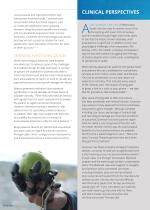 Website:
Naked Prosthetics
Website:
Naked Prosthetics
Catalog excerpts

A Smart Brief Update SmartFocus on Prosthetic Devices HIGH-TECH HANDS How advances in design and manufacturing are enabling a new paradigm for digit amputation care Technological advances have given orthotic and prosthetic professionals a wealth of new options for helping patients with limb loss to regain function.1 However, O&P practices have had far fewer options for patients who have experienced amputation of one or more fingers. Although digit loss is common, prosthetic solutions for this population have until recently been restricted largely to cosmetic devices with limited functionality.2,3 Finger and thumb amputations carry physiological, lifestyle and psychological effects, but anatomical and production challenges have impeded development of functional prostheses for these patients. Fortunately, advances in prosthetic technology, computer-aided design and manufacturing are bringing new options to this underserved population, equipping clinicians with effective solutions to help patients re-engage fully in their lives.2,3,4 PREVALENCE AND ETIOLOGY In 2005, 1.6 million Americans were living with limb loss, with 35% of cases involving the upper limbs. Although lower-limb loss is heavily associated with chronic disease and old age, upper-limb loss most commonly afflicts working-age men, and it is almost exclusively secondary to trauma. Ninety-two percent of these traumatic upper-limb amputations involve loss of a finger or thumb. Altogether, 45,000 traumatic finger amputations are believed to occur in the US each year.35 Many of these injuries occur in the workplace, often involving machinery or powered hand tools. More than half of digit or partial-hand amputees are unable to continue their previous careers and may go on to become unemployed. Those whose work requires manual labor are particularly likely to leave their jobs after an injury. These changes carry lifestyle and psychosocial consequences for patients themselves as well as economic implications for society. 36,7,8
Open the catalog to page 1
When Matthew Finney developed an infection after surgery to treat blood clots in his right arm, the loss of his thumb and portions of three other fingers was devastating. Facing major physiological changes as well as the psychological blow, Finney says he felt he had to start over in many areas of his life. And the amputations also severely restricted the cement mason's ability to work. Finney underwent physical therapy and was fitted for a prosthesis, custom made by his clinician in an attempt to restore opposition. He tried returning to work with the device but found it bulky and...
Open the catalog to page 2
consciousness and improved comfort with interactions involving hands. Cosmeses also can provide limited functional support, such as moderate stabilization when grasping. However, these functional benefits are minimal, and not all patients experience them. For the most part, cosmeses serve psychological purposes, but they are not a practical solution for most people who need restoration of function for work or other pursuits.3'11'12 EMERGING FUNCTIONAL DEVICES Recent technological advances have enabled manufacturers to address some of the challenges of prosthetic design for digit amputees. A...
Open the catalog to page 3
a There is no need for specialized training, and users report that with time, the prostheses begin to feel like an endogenous extension of Operated by the user through intuitive movement and powered by intact PIP or MCP joints, finger-driven prostheses can restore active grip and pinch force in many clinical scenarios. There is no need for specialized training, and users report that with time, the prostheses begin to feel like an endogenous extension of the body.3'4,12'13 The newest generation of high-durability, body-powered prostheses allows these devices to be used in welding, auto and...
Open the catalog to page 4
LITERATURE CITED 1. Harvey, Z. T., Potter, B. K., Vandersea, J., Wolf, E. (2012) Prosthetic advances. Journal of Surgical Orthopaedic Advances. 21: 58-64. 2. Ziegler-Graham, K., MacKenzie, E. J., Ephraim, P. L., Travison, T. G., and Brookmeyer, R. (2008) Estimating the prevalence of limb loss in the United States: 2005 to 2050. Archives of Physical Medicine and Rehabilitation. 89: 422-429. 3. Imbinto, I., Peccia, C., Controzzi, M., Cutti, A. G., et al. (2016) Treatment of the partial hand amputation. IEEE Reviews in Biomedical Engineering. 9: 32-48. 4. Denham, S., Hawkins, T., Johnson, K.,...
Open the catalog to page 5All Naked Prosthetics catalogs and technical brochures
-
Function
3 Pages
-
PIPDriver
1 Pages
-
MCP Driver
1 Pages
-
MCPDriver
3 Pages





